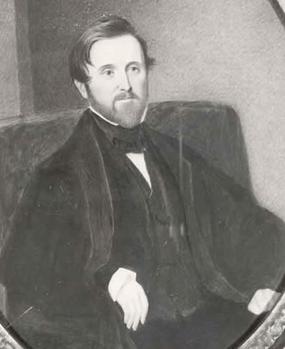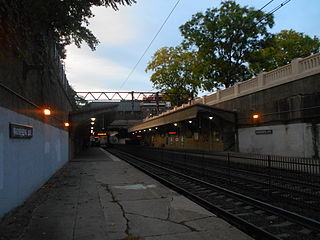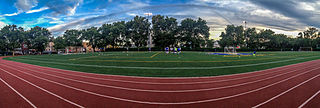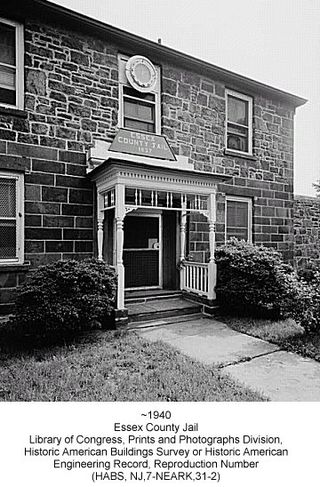
Montclair is a township in Essex County in the U.S. state of New Jersey. Situated on the cliffs of the Watchung Mountains, Montclair is a commercial and cultural hub of North Jersey and a diverse bedroom community of New York City within the New York metropolitan area. The township is the home of Montclair State University, the state's second largest university

Branch Brook Park is a county park of Essex County, New Jersey. It is located in the North Ward of Newark, between the neighborhoods of Forest Hill and Roseville. A portion of the park is also located within the Township of Belleville. At 360 acres (150 ha), Branch Brook Park is the largest public park in the city of Newark. The park is noted for the largest collection of cherry blossom trees in the United States, having over 5,000 in more than eighteen different varieties collectively called Cherryblossomland, as well as its spectacular Cherry Blossom Festival each April.

Forest Hill is a neighborhood in the city of Newark in Essex County, in the U.S. state of New Jersey. It is a pre-World War II neighborhood in the North Ward. It is bounded on the west by Branch Brook Park, on the south by Bloomfield Avenue, and on the east by both Summer and Mt. Prospect Avenues, the neighborhood of Broadway. The neighborhood's ZIP Code is 07104.

Alexander Jackson Davis was an American architect known particularly for his association with the Gothic Revival style.

Llewellyn Park is a historic gated community and census-designated place (CDP) located within West Orange in Essex County, in the U.S. state of New Jersey. Llewellyn Park is thought to be the country's first planned residential community, and the site of the first large-scale naturalization of crocus, narcissus, and jonquils. The community features 175 homes on 425 acres (172 ha) and is located 12 miles (19 km) west of New York City.

Watsessing Avenue station is a New Jersey Transit rail station in Bloomfield, New Jersey, along the Montclair-Boonton Line. It is located beneath the Bloomfield Police Benevolent Association meeting hall near the corner of Watsessing Avenue and Orange Street in Bloomfield. It is one of two stations on the line where the boarding platform is below ground level. The Watsessing station and the Kingsland station in Lyndhurst on the Main Line shared similar designs and were built about the same time.

Bloomfield is a New Jersey Transit station in Bloomfield, New Jersey along the Montclair-Boonton Line. The station is located in downtown Bloomfield, the second within the municipality, just west of Bloomfield Avenue. This is the second station within the township served on the line after Watsessing Avenue station.

Lincoln Park is a city square and neighborhood, also known as "the Coast," in Newark, Essex County, New Jersey, United States. It is bounded by the Springfield/Belmont, South Broad Valley, South Ironbound and Downtown neighborhoods. It is bounded by Martin Luther King Jr. Blvd. to the west, West Kinney St. to the north, the McCarter Highway to the east and South St., Pennsylvania Avenue, Lincoln Park and Clinton Avenue to the south. Part of the neighborhood is a historic district listed on the New Jersey Register of Historic Places and the National Register of Historic Places. Lincoln Park as a street turns into Clinton Avenue toward the south and north edge of the park.

Military Park is a 6-acre (24,000 m2) city park in Downtown Newark in Newark, New Jersey. Along with Lincoln Park and Washington Park, it makes up the three downtown parks in Newark that were laid out in the colonial era. It is a nearly triangular park located between Park Place, Rector Street and Broad Street.

The Rochelle Park–Rochelle Heights Historic District is a historic residential district located in the city of New Rochelle in Westchester, New York. The district is historically and architecturally significant as an intact and distinctive example of residential park development at the turn of the Twentieth Century. It includes the historic Rochelle Park development, and the later Rochelle Heights subdivision. Within the district are 555 contributing properties, including 513 buildings, 38 structures, and 4 sites. Only 24 buildings and 1 site separately identified within its area are non-contributing. It was listed on the National Register of Historic Places (NRHP) on July 6, 2005.

Ampere, formerly known as The Crescent, is a defunct stop on New Jersey Transit's Montclair-Boonton Line in the city of East Orange, Essex County, New Jersey, United States. A station was first built there in 1890 to service to new Crocker Wheeler plant in the district. The stop was named in honor of André-Marie Ampère, a pioneer in electrodynamics and reconstructed as a new Renaissance Revival station in 1908. Ampere was the second stop on the branch west of Newark Broad Street Station until 1984, when the Roseville Avenue station was closed. In June of that year, the station, along with 42 others, was entered into the National Register of Historic Places. In 1986, after continuous deterioration, New Jersey Transit demolished the westbound shelter built in 1921. The agency discontinued rail service to Ampere on April 7, 1991. The entire station was demolished in 1995.

The Grover Cleveland Birthplace is a historic site located at 207 Bloomfield Avenue in Caldwell, Essex County, New Jersey, United States. It is the only house museum dedicated to U.S. President Grover Cleveland.

Riverbank Park is a park in the Ironbound section of Newark, Essex County, New Jersey, United States. The park was opened in 1910 and was added to the National Register of Historic Places on April 16, 1998. It is the smallest and one of the most heavily used parks in the Essex County Park System.

The old Essex County Jail is located in the University Heights section of Newark, Essex County, New Jersey, United States. The jail is Essex County's oldest public building and a national landmark of value for its architectural and social history. The complex consists of about 20 structures of various size, age, and function ranging in date from the 1830s to 1930s. Collectively, they represent the evolution of American prison history over 100 years. For the quality of its architecture, its social history, and its links to the 1967 Newark Riots, this jail was added to the National Register of Historic Places on September 3, 1991.

The New Jersey Bell Headquarters Building is located in Newark, Essex County, New Jersey, United States. The building was built in 1929 by the New Jersey Bell Telephone Company and was added to the National Register of Historic Places on September 21, 2005. The art deco building was designed by Ralph Thomas Walker of the architectural firm Voorhees, Gmelin, and Walker. The buff brick and sandstone façade is decorated with pilasters created by sculptor Edward McCartan. Since the building's opening, soft orange lights have bathed its upper floors at night. The building is 20 stories and 275 ft (84 m) tall. The building later became headquarters for Verizon New Jersey, Inc.

The Four Corners Historic District is the intersection of Broad and Market Streets in Newark, New Jersey. It is the site of the city's earliest settlement and the heart of Downtown Newark that at one time was considered the busiest intersection in the United States. The area that radiates twenty-two square blocks from the crossroads is a state and federal historic district.

Nathan Franklin Barrett was an American landscape architect. He is best known for his designs for company town of Pullman, Illinois, the Hotel Ponce de Leon in Florida and Naumkeag in Stockbridge, Massachusetts. Barrett was a founding member and president of the American Society of Landscape Architects. He also maintained a long working relationship with many noted architects and firms of the time including those of McKim, Mead & White, Carrère and Hastings and Horace Trumbauer.

Saint John's Episcopal Church in Jersey City, New Jersey is a disused church of the Episcopal Diocese of Newark. Located on Summit Avenue in Bergen Hill, it is considered a masterwork of 19th-century ecclesiastical architecture. The building, which was named a municipal landmark in 2013, has not housed a congregation since 1994, and has fallen into disrepair. There are proposals to convert the buildings on the grounds to housing.

Rutherfurd Hall is a historic house located in Allamuchy Township, Warren County, New Jersey, US.

Harriet Tubman Square is a city square in Downtown Newark, New Jersey.























